Motivation in the World of Work: Factors, Experiences & Strategies
VerifiedAdded on 2023/06/14
|8
|2109
|247
Report
AI Summary
This report provides an in-depth analysis of motivation in the workplace, defining motivation as the process of guiding and stimulating employees to achieve organizational objectives. It identifies various factors that motivate employees, including financial benefits, meaning and purpose, recognition and appreciation, flexible working schedules, and a positive organizational culture. The report also discusses positive employee experiences such as growth opportunities, modern performance management, and a supportive working environment, as well as negative experiences like conflicts, excessive workloads, and organizational hassles. Furthermore, it outlines strategies to cope with negative factors, such as providing opportunities for employees to express opinions, ensuring consistent and fair treatment, and granting employees control over their job roles, ultimately aiming to enhance employee performance and organizational productivity. Desklib offers more resources like this to support student learning.
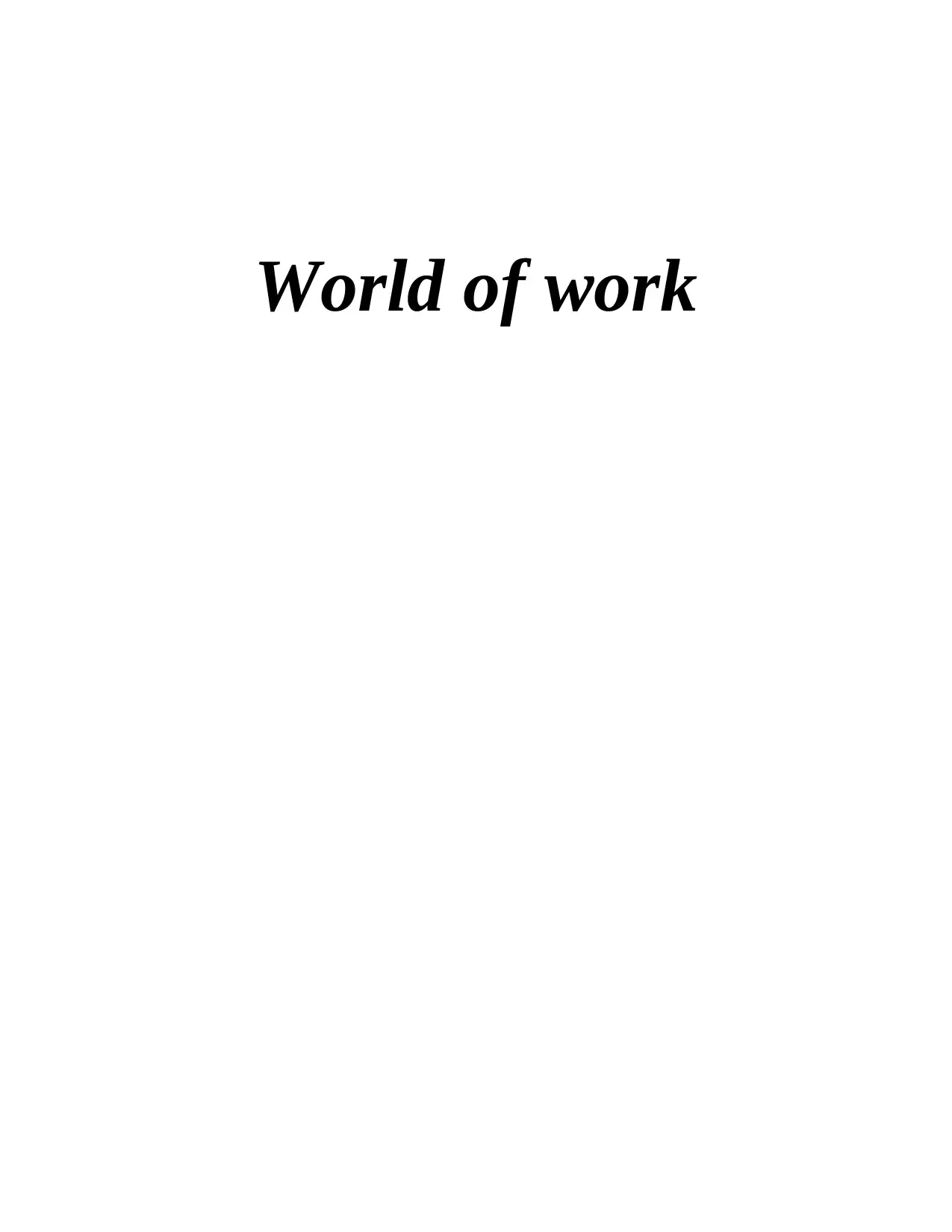
World of work
Paraphrase This Document
Need a fresh take? Get an instant paraphrase of this document with our AI Paraphraser
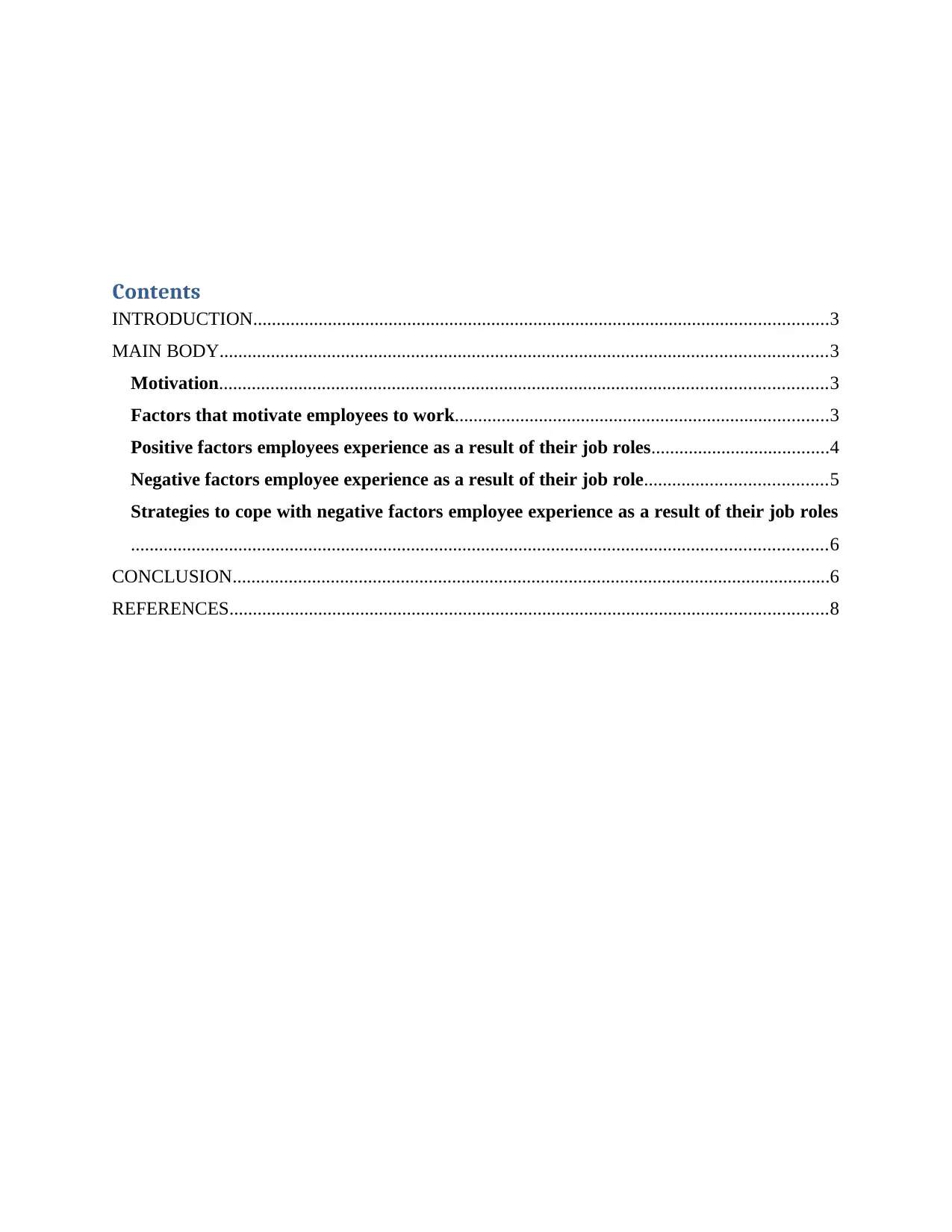
Contents
INTRODUCTION...........................................................................................................................3
MAIN BODY..................................................................................................................................3
Motivation..................................................................................................................................3
Factors that motivate employees to work................................................................................3
Positive factors employees experience as a result of their job roles......................................4
Negative factors employee experience as a result of their job role.......................................5
Strategies to cope with negative factors employee experience as a result of their job roles
.....................................................................................................................................................6
CONCLUSION................................................................................................................................6
REFERENCES................................................................................................................................8
INTRODUCTION...........................................................................................................................3
MAIN BODY..................................................................................................................................3
Motivation..................................................................................................................................3
Factors that motivate employees to work................................................................................3
Positive factors employees experience as a result of their job roles......................................4
Negative factors employee experience as a result of their job role.......................................5
Strategies to cope with negative factors employee experience as a result of their job roles
.....................................................................................................................................................6
CONCLUSION................................................................................................................................6
REFERENCES................................................................................................................................8
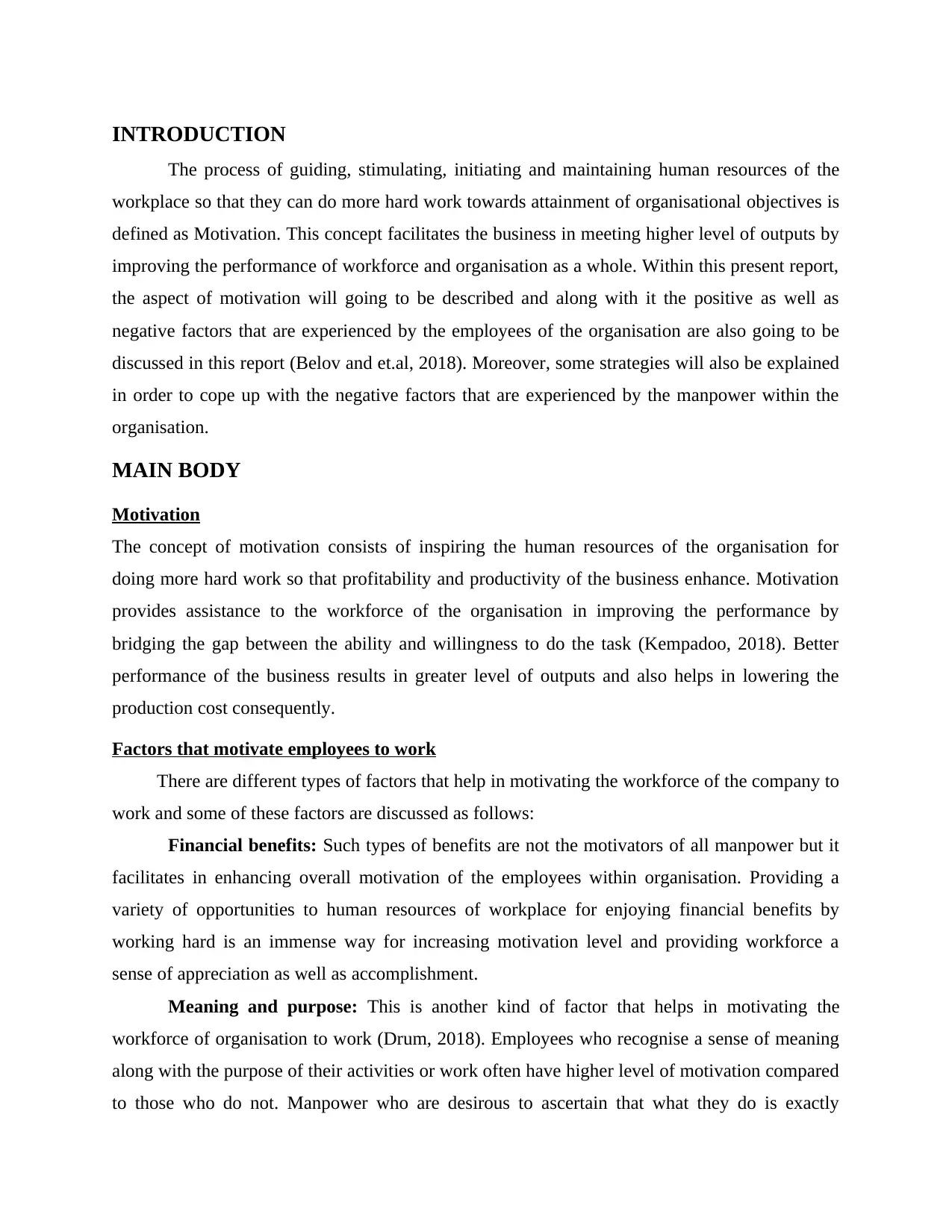
INTRODUCTION
The process of guiding, stimulating, initiating and maintaining human resources of the
workplace so that they can do more hard work towards attainment of organisational objectives is
defined as Motivation. This concept facilitates the business in meeting higher level of outputs by
improving the performance of workforce and organisation as a whole. Within this present report,
the aspect of motivation will going to be described and along with it the positive as well as
negative factors that are experienced by the employees of the organisation are also going to be
discussed in this report (Belov and et.al, 2018). Moreover, some strategies will also be explained
in order to cope up with the negative factors that are experienced by the manpower within the
organisation.
MAIN BODY
Motivation
The concept of motivation consists of inspiring the human resources of the organisation for
doing more hard work so that profitability and productivity of the business enhance. Motivation
provides assistance to the workforce of the organisation in improving the performance by
bridging the gap between the ability and willingness to do the task (Kempadoo, 2018). Better
performance of the business results in greater level of outputs and also helps in lowering the
production cost consequently.
Factors that motivate employees to work
There are different types of factors that help in motivating the workforce of the company to
work and some of these factors are discussed as follows:
Financial benefits: Such types of benefits are not the motivators of all manpower but it
facilitates in enhancing overall motivation of the employees within organisation. Providing a
variety of opportunities to human resources of workplace for enjoying financial benefits by
working hard is an immense way for increasing motivation level and providing workforce a
sense of appreciation as well as accomplishment.
Meaning and purpose: This is another kind of factor that helps in motivating the
workforce of organisation to work (Drum, 2018). Employees who recognise a sense of meaning
along with the purpose of their activities or work often have higher level of motivation compared
to those who do not. Manpower who are desirous to ascertain that what they do is exactly
The process of guiding, stimulating, initiating and maintaining human resources of the
workplace so that they can do more hard work towards attainment of organisational objectives is
defined as Motivation. This concept facilitates the business in meeting higher level of outputs by
improving the performance of workforce and organisation as a whole. Within this present report,
the aspect of motivation will going to be described and along with it the positive as well as
negative factors that are experienced by the employees of the organisation are also going to be
discussed in this report (Belov and et.al, 2018). Moreover, some strategies will also be explained
in order to cope up with the negative factors that are experienced by the manpower within the
organisation.
MAIN BODY
Motivation
The concept of motivation consists of inspiring the human resources of the organisation for
doing more hard work so that profitability and productivity of the business enhance. Motivation
provides assistance to the workforce of the organisation in improving the performance by
bridging the gap between the ability and willingness to do the task (Kempadoo, 2018). Better
performance of the business results in greater level of outputs and also helps in lowering the
production cost consequently.
Factors that motivate employees to work
There are different types of factors that help in motivating the workforce of the company to
work and some of these factors are discussed as follows:
Financial benefits: Such types of benefits are not the motivators of all manpower but it
facilitates in enhancing overall motivation of the employees within organisation. Providing a
variety of opportunities to human resources of workplace for enjoying financial benefits by
working hard is an immense way for increasing motivation level and providing workforce a
sense of appreciation as well as accomplishment.
Meaning and purpose: This is another kind of factor that helps in motivating the
workforce of organisation to work (Drum, 2018). Employees who recognise a sense of meaning
along with the purpose of their activities or work often have higher level of motivation compared
to those who do not. Manpower who are desirous to ascertain that what they do is exactly
⊘ This is a preview!⊘
Do you want full access?
Subscribe today to unlock all pages.

Trusted by 1+ million students worldwide
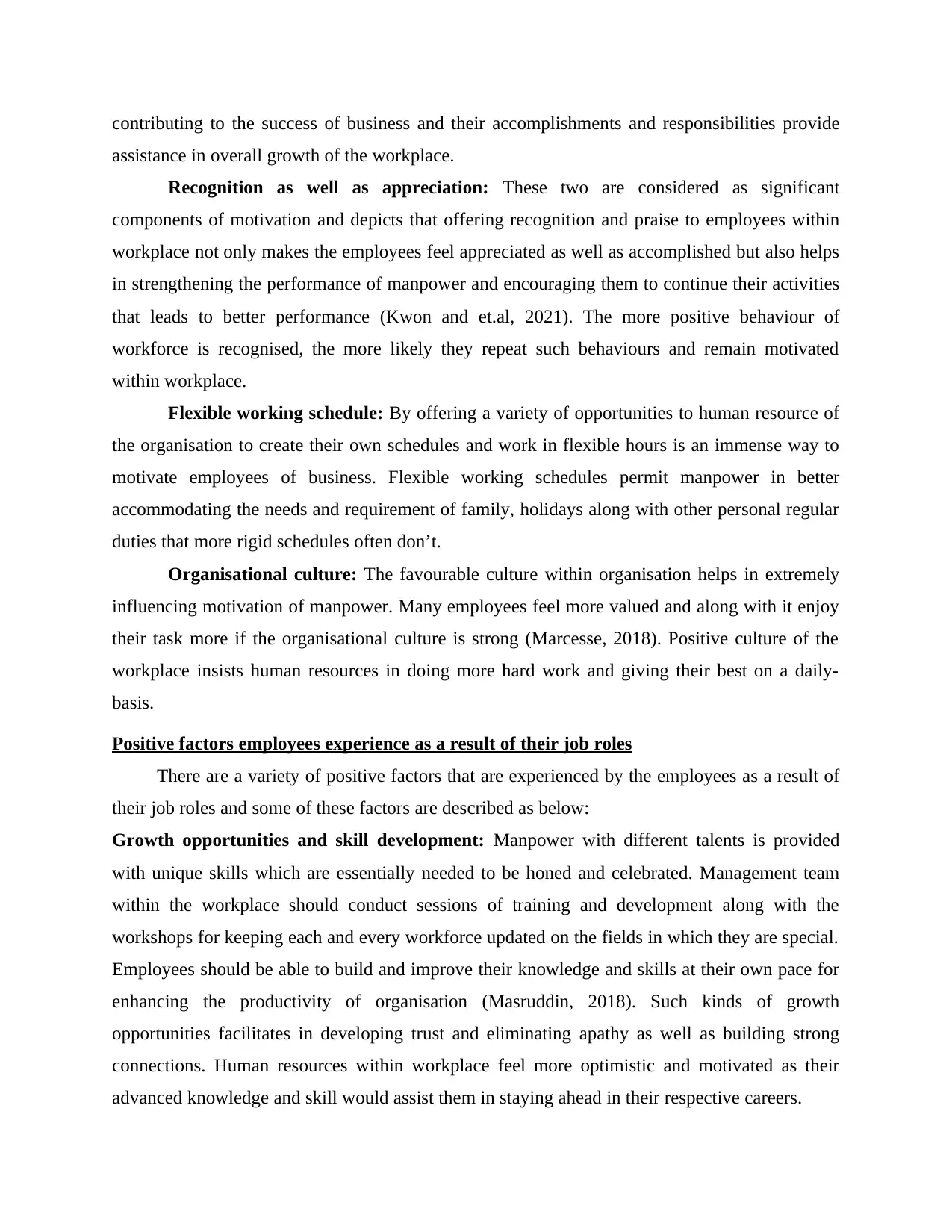
contributing to the success of business and their accomplishments and responsibilities provide
assistance in overall growth of the workplace.
Recognition as well as appreciation: These two are considered as significant
components of motivation and depicts that offering recognition and praise to employees within
workplace not only makes the employees feel appreciated as well as accomplished but also helps
in strengthening the performance of manpower and encouraging them to continue their activities
that leads to better performance (Kwon and et.al, 2021). The more positive behaviour of
workforce is recognised, the more likely they repeat such behaviours and remain motivated
within workplace.
Flexible working schedule: By offering a variety of opportunities to human resource of
the organisation to create their own schedules and work in flexible hours is an immense way to
motivate employees of business. Flexible working schedules permit manpower in better
accommodating the needs and requirement of family, holidays along with other personal regular
duties that more rigid schedules often don’t.
Organisational culture: The favourable culture within organisation helps in extremely
influencing motivation of manpower. Many employees feel more valued and along with it enjoy
their task more if the organisational culture is strong (Marcesse, 2018). Positive culture of the
workplace insists human resources in doing more hard work and giving their best on a daily-
basis.
Positive factors employees experience as a result of their job roles
There are a variety of positive factors that are experienced by the employees as a result of
their job roles and some of these factors are described as below:
Growth opportunities and skill development: Manpower with different talents is provided
with unique skills which are essentially needed to be honed and celebrated. Management team
within the workplace should conduct sessions of training and development along with the
workshops for keeping each and every workforce updated on the fields in which they are special.
Employees should be able to build and improve their knowledge and skills at their own pace for
enhancing the productivity of organisation (Masruddin, 2018). Such kinds of growth
opportunities facilitates in developing trust and eliminating apathy as well as building strong
connections. Human resources within workplace feel more optimistic and motivated as their
advanced knowledge and skill would assist them in staying ahead in their respective careers.
assistance in overall growth of the workplace.
Recognition as well as appreciation: These two are considered as significant
components of motivation and depicts that offering recognition and praise to employees within
workplace not only makes the employees feel appreciated as well as accomplished but also helps
in strengthening the performance of manpower and encouraging them to continue their activities
that leads to better performance (Kwon and et.al, 2021). The more positive behaviour of
workforce is recognised, the more likely they repeat such behaviours and remain motivated
within workplace.
Flexible working schedule: By offering a variety of opportunities to human resource of
the organisation to create their own schedules and work in flexible hours is an immense way to
motivate employees of business. Flexible working schedules permit manpower in better
accommodating the needs and requirement of family, holidays along with other personal regular
duties that more rigid schedules often don’t.
Organisational culture: The favourable culture within organisation helps in extremely
influencing motivation of manpower. Many employees feel more valued and along with it enjoy
their task more if the organisational culture is strong (Marcesse, 2018). Positive culture of the
workplace insists human resources in doing more hard work and giving their best on a daily-
basis.
Positive factors employees experience as a result of their job roles
There are a variety of positive factors that are experienced by the employees as a result of
their job roles and some of these factors are described as below:
Growth opportunities and skill development: Manpower with different talents is provided
with unique skills which are essentially needed to be honed and celebrated. Management team
within the workplace should conduct sessions of training and development along with the
workshops for keeping each and every workforce updated on the fields in which they are special.
Employees should be able to build and improve their knowledge and skills at their own pace for
enhancing the productivity of organisation (Masruddin, 2018). Such kinds of growth
opportunities facilitates in developing trust and eliminating apathy as well as building strong
connections. Human resources within workplace feel more optimistic and motivated as their
advanced knowledge and skill would assist them in staying ahead in their respective careers.
Paraphrase This Document
Need a fresh take? Get an instant paraphrase of this document with our AI Paraphraser
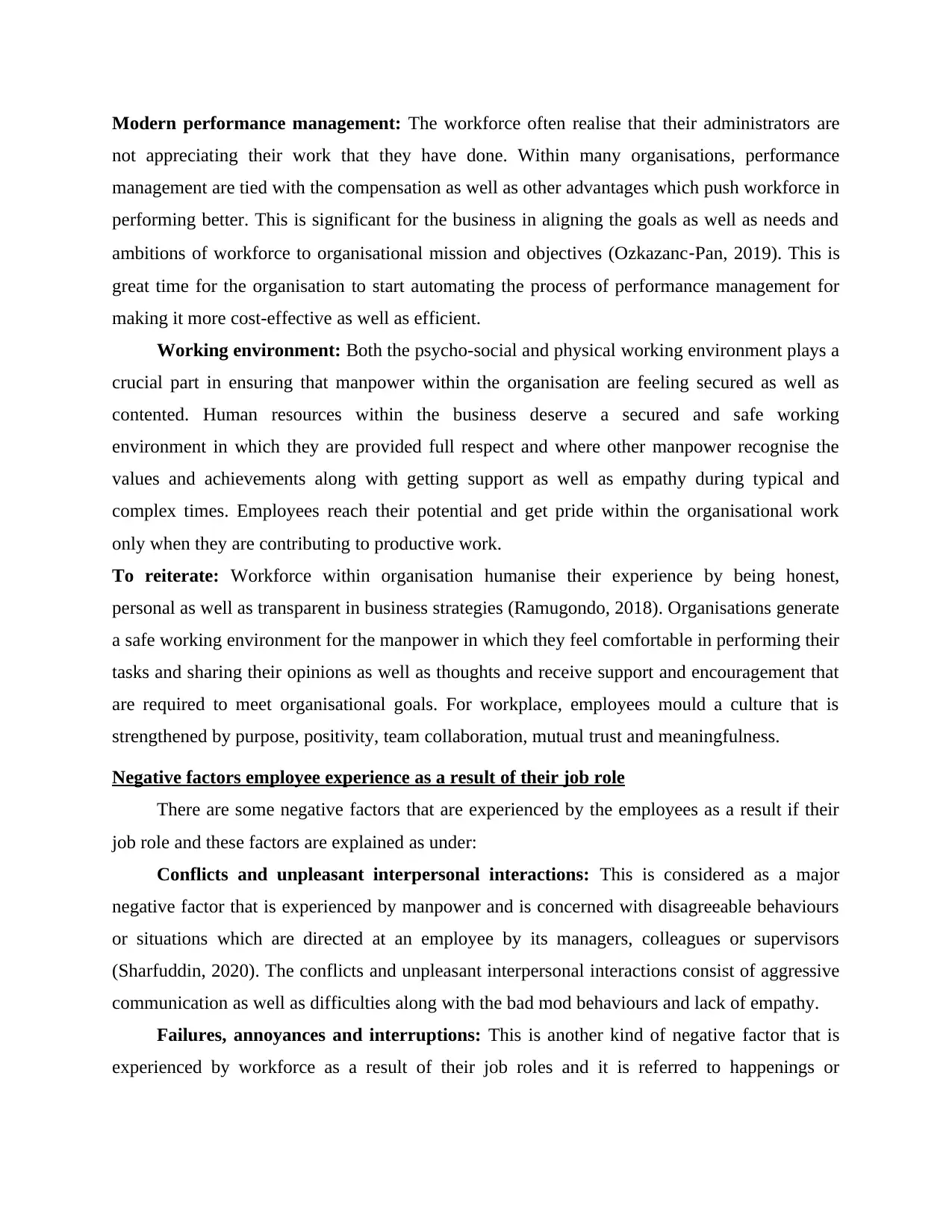
Modern performance management: The workforce often realise that their administrators are
not appreciating their work that they have done. Within many organisations, performance
management are tied with the compensation as well as other advantages which push workforce in
performing better. This is significant for the business in aligning the goals as well as needs and
ambitions of workforce to organisational mission and objectives (Ozkazanc‐Pan, 2019). This is
great time for the organisation to start automating the process of performance management for
making it more cost-effective as well as efficient.
Working environment: Both the psycho-social and physical working environment plays a
crucial part in ensuring that manpower within the organisation are feeling secured as well as
contented. Human resources within the business deserve a secured and safe working
environment in which they are provided full respect and where other manpower recognise the
values and achievements along with getting support as well as empathy during typical and
complex times. Employees reach their potential and get pride within the organisational work
only when they are contributing to productive work.
To reiterate: Workforce within organisation humanise their experience by being honest,
personal as well as transparent in business strategies (Ramugondo, 2018). Organisations generate
a safe working environment for the manpower in which they feel comfortable in performing their
tasks and sharing their opinions as well as thoughts and receive support and encouragement that
are required to meet organisational goals. For workplace, employees mould a culture that is
strengthened by purpose, positivity, team collaboration, mutual trust and meaningfulness.
Negative factors employee experience as a result of their job role
There are some negative factors that are experienced by the employees as a result if their
job role and these factors are explained as under:
Conflicts and unpleasant interpersonal interactions: This is considered as a major
negative factor that is experienced by manpower and is concerned with disagreeable behaviours
or situations which are directed at an employee by its managers, colleagues or supervisors
(Sharfuddin, 2020). The conflicts and unpleasant interpersonal interactions consist of aggressive
communication as well as difficulties along with the bad mod behaviours and lack of empathy.
Failures, annoyances and interruptions: This is another kind of negative factor that is
experienced by workforce as a result of their job roles and it is referred to happenings or
not appreciating their work that they have done. Within many organisations, performance
management are tied with the compensation as well as other advantages which push workforce in
performing better. This is significant for the business in aligning the goals as well as needs and
ambitions of workforce to organisational mission and objectives (Ozkazanc‐Pan, 2019). This is
great time for the organisation to start automating the process of performance management for
making it more cost-effective as well as efficient.
Working environment: Both the psycho-social and physical working environment plays a
crucial part in ensuring that manpower within the organisation are feeling secured as well as
contented. Human resources within the business deserve a secured and safe working
environment in which they are provided full respect and where other manpower recognise the
values and achievements along with getting support as well as empathy during typical and
complex times. Employees reach their potential and get pride within the organisational work
only when they are contributing to productive work.
To reiterate: Workforce within organisation humanise their experience by being honest,
personal as well as transparent in business strategies (Ramugondo, 2018). Organisations generate
a safe working environment for the manpower in which they feel comfortable in performing their
tasks and sharing their opinions as well as thoughts and receive support and encouragement that
are required to meet organisational goals. For workplace, employees mould a culture that is
strengthened by purpose, positivity, team collaboration, mutual trust and meaningfulness.
Negative factors employee experience as a result of their job role
There are some negative factors that are experienced by the employees as a result if their
job role and these factors are explained as under:
Conflicts and unpleasant interpersonal interactions: This is considered as a major
negative factor that is experienced by manpower and is concerned with disagreeable behaviours
or situations which are directed at an employee by its managers, colleagues or supervisors
(Sharfuddin, 2020). The conflicts and unpleasant interpersonal interactions consist of aggressive
communication as well as difficulties along with the bad mod behaviours and lack of empathy.
Failures, annoyances and interruptions: This is another kind of negative factor that is
experienced by workforce as a result of their job roles and it is referred to happenings or
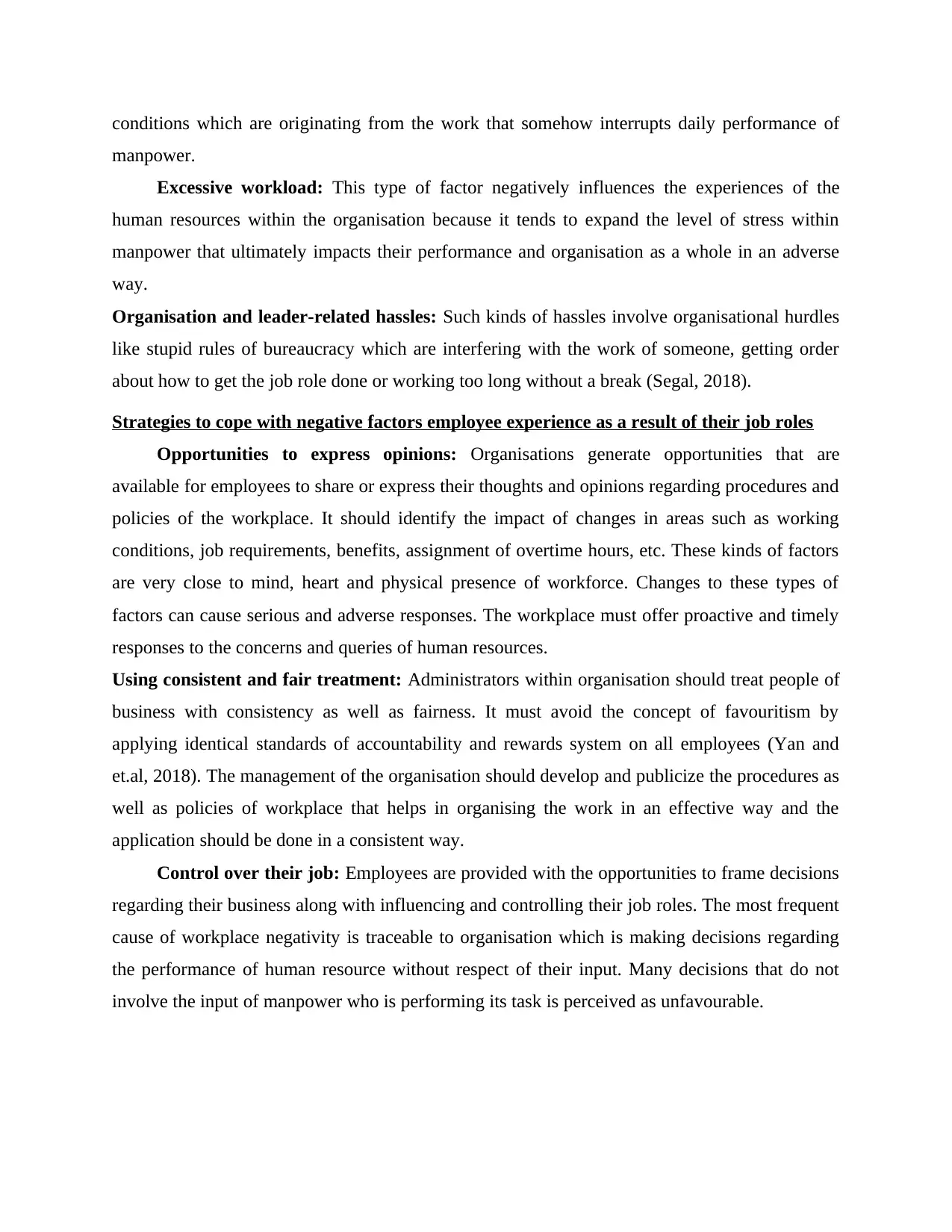
conditions which are originating from the work that somehow interrupts daily performance of
manpower.
Excessive workload: This type of factor negatively influences the experiences of the
human resources within the organisation because it tends to expand the level of stress within
manpower that ultimately impacts their performance and organisation as a whole in an adverse
way.
Organisation and leader-related hassles: Such kinds of hassles involve organisational hurdles
like stupid rules of bureaucracy which are interfering with the work of someone, getting order
about how to get the job role done or working too long without a break (Segal, 2018).
Strategies to cope with negative factors employee experience as a result of their job roles
Opportunities to express opinions: Organisations generate opportunities that are
available for employees to share or express their thoughts and opinions regarding procedures and
policies of the workplace. It should identify the impact of changes in areas such as working
conditions, job requirements, benefits, assignment of overtime hours, etc. These kinds of factors
are very close to mind, heart and physical presence of workforce. Changes to these types of
factors can cause serious and adverse responses. The workplace must offer proactive and timely
responses to the concerns and queries of human resources.
Using consistent and fair treatment: Administrators within organisation should treat people of
business with consistency as well as fairness. It must avoid the concept of favouritism by
applying identical standards of accountability and rewards system on all employees (Yan and
et.al, 2018). The management of the organisation should develop and publicize the procedures as
well as policies of workplace that helps in organising the work in an effective way and the
application should be done in a consistent way.
Control over their job: Employees are provided with the opportunities to frame decisions
regarding their business along with influencing and controlling their job roles. The most frequent
cause of workplace negativity is traceable to organisation which is making decisions regarding
the performance of human resource without respect of their input. Many decisions that do not
involve the input of manpower who is performing its task is perceived as unfavourable.
manpower.
Excessive workload: This type of factor negatively influences the experiences of the
human resources within the organisation because it tends to expand the level of stress within
manpower that ultimately impacts their performance and organisation as a whole in an adverse
way.
Organisation and leader-related hassles: Such kinds of hassles involve organisational hurdles
like stupid rules of bureaucracy which are interfering with the work of someone, getting order
about how to get the job role done or working too long without a break (Segal, 2018).
Strategies to cope with negative factors employee experience as a result of their job roles
Opportunities to express opinions: Organisations generate opportunities that are
available for employees to share or express their thoughts and opinions regarding procedures and
policies of the workplace. It should identify the impact of changes in areas such as working
conditions, job requirements, benefits, assignment of overtime hours, etc. These kinds of factors
are very close to mind, heart and physical presence of workforce. Changes to these types of
factors can cause serious and adverse responses. The workplace must offer proactive and timely
responses to the concerns and queries of human resources.
Using consistent and fair treatment: Administrators within organisation should treat people of
business with consistency as well as fairness. It must avoid the concept of favouritism by
applying identical standards of accountability and rewards system on all employees (Yan and
et.al, 2018). The management of the organisation should develop and publicize the procedures as
well as policies of workplace that helps in organising the work in an effective way and the
application should be done in a consistent way.
Control over their job: Employees are provided with the opportunities to frame decisions
regarding their business along with influencing and controlling their job roles. The most frequent
cause of workplace negativity is traceable to organisation which is making decisions regarding
the performance of human resource without respect of their input. Many decisions that do not
involve the input of manpower who is performing its task is perceived as unfavourable.
⊘ This is a preview!⊘
Do you want full access?
Subscribe today to unlock all pages.

Trusted by 1+ million students worldwide
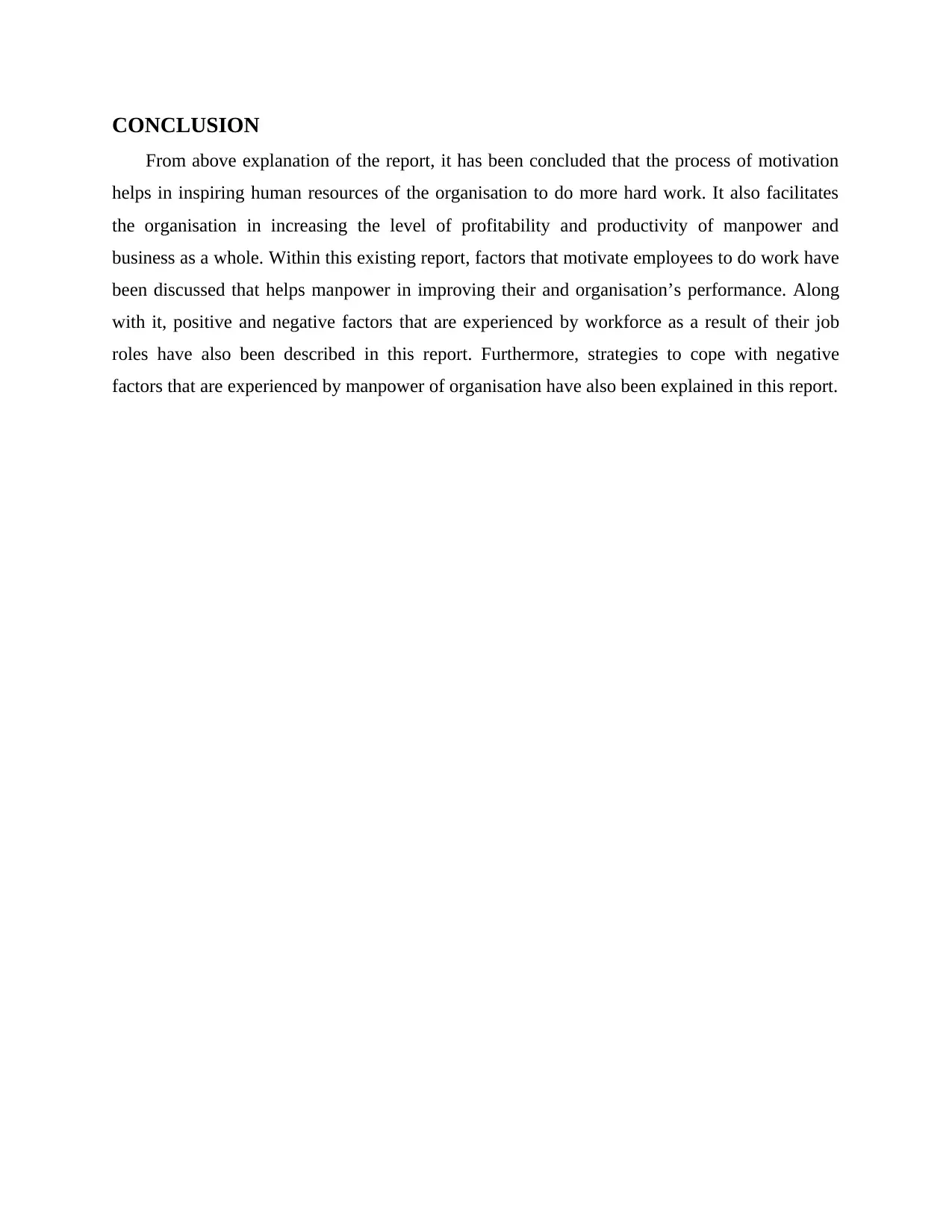
CONCLUSION
From above explanation of the report, it has been concluded that the process of motivation
helps in inspiring human resources of the organisation to do more hard work. It also facilitates
the organisation in increasing the level of profitability and productivity of manpower and
business as a whole. Within this existing report, factors that motivate employees to do work have
been discussed that helps manpower in improving their and organisation’s performance. Along
with it, positive and negative factors that are experienced by workforce as a result of their job
roles have also been described in this report. Furthermore, strategies to cope with negative
factors that are experienced by manpower of organisation have also been explained in this report.
From above explanation of the report, it has been concluded that the process of motivation
helps in inspiring human resources of the organisation to do more hard work. It also facilitates
the organisation in increasing the level of profitability and productivity of manpower and
business as a whole. Within this existing report, factors that motivate employees to do work have
been discussed that helps manpower in improving their and organisation’s performance. Along
with it, positive and negative factors that are experienced by workforce as a result of their job
roles have also been described in this report. Furthermore, strategies to cope with negative
factors that are experienced by manpower of organisation have also been explained in this report.
Paraphrase This Document
Need a fresh take? Get an instant paraphrase of this document with our AI Paraphraser
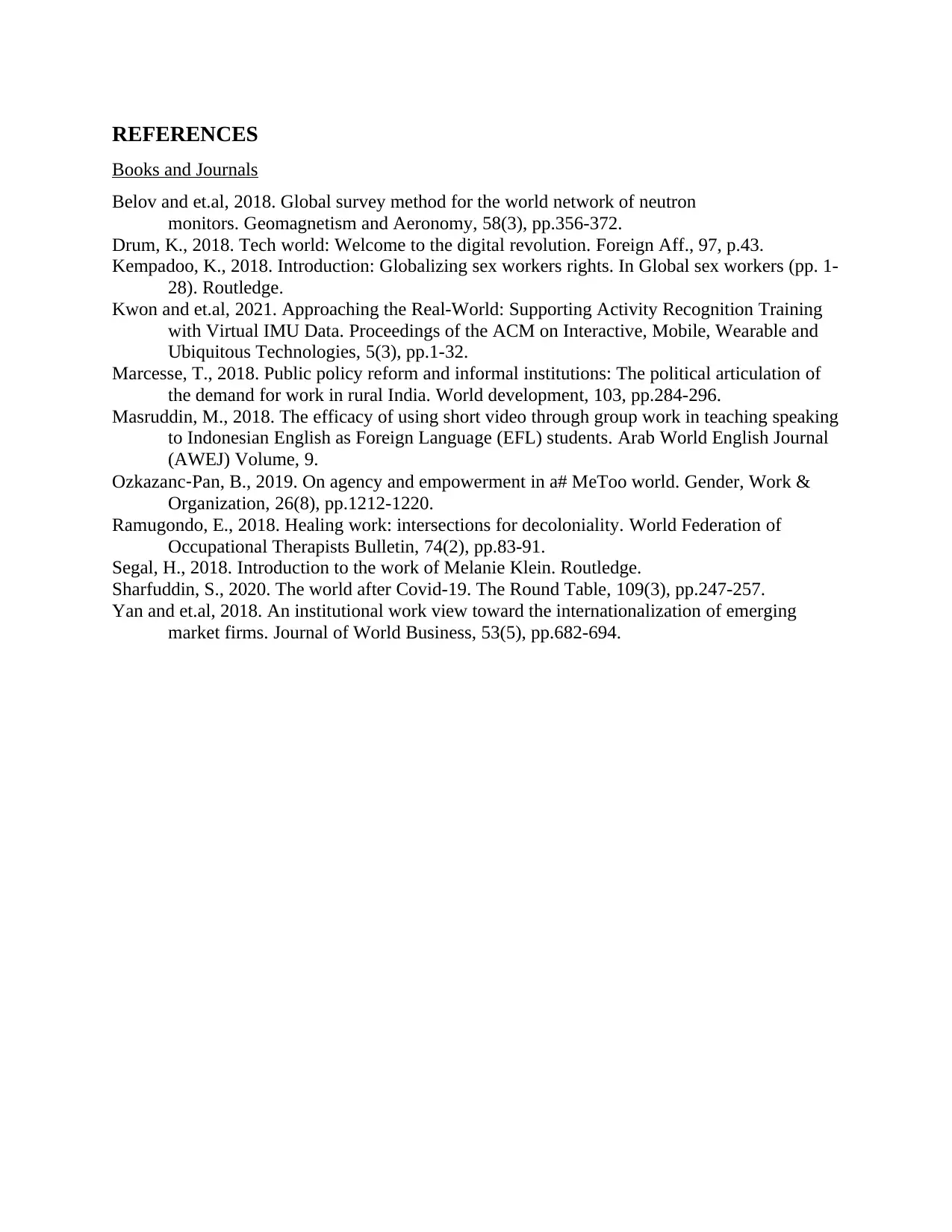
REFERENCES
Books and Journals
Belov and et.al, 2018. Global survey method for the world network of neutron
monitors. Geomagnetism and Aeronomy, 58(3), pp.356-372.
Drum, K., 2018. Tech world: Welcome to the digital revolution. Foreign Aff., 97, p.43.
Kempadoo, K., 2018. Introduction: Globalizing sex workers rights. In Global sex workers (pp. 1-
28). Routledge.
Kwon and et.al, 2021. Approaching the Real-World: Supporting Activity Recognition Training
with Virtual IMU Data. Proceedings of the ACM on Interactive, Mobile, Wearable and
Ubiquitous Technologies, 5(3), pp.1-32.
Marcesse, T., 2018. Public policy reform and informal institutions: The political articulation of
the demand for work in rural India. World development, 103, pp.284-296.
Masruddin, M., 2018. The efficacy of using short video through group work in teaching speaking
to Indonesian English as Foreign Language (EFL) students. Arab World English Journal
(AWEJ) Volume, 9.
Ozkazanc‐Pan, B., 2019. On agency and empowerment in a# MeToo world. Gender, Work &
Organization, 26(8), pp.1212-1220.
Ramugondo, E., 2018. Healing work: intersections for decoloniality. World Federation of
Occupational Therapists Bulletin, 74(2), pp.83-91.
Segal, H., 2018. Introduction to the work of Melanie Klein. Routledge.
Sharfuddin, S., 2020. The world after Covid-19. The Round Table, 109(3), pp.247-257.
Yan and et.al, 2018. An institutional work view toward the internationalization of emerging
market firms. Journal of World Business, 53(5), pp.682-694.
Books and Journals
Belov and et.al, 2018. Global survey method for the world network of neutron
monitors. Geomagnetism and Aeronomy, 58(3), pp.356-372.
Drum, K., 2018. Tech world: Welcome to the digital revolution. Foreign Aff., 97, p.43.
Kempadoo, K., 2018. Introduction: Globalizing sex workers rights. In Global sex workers (pp. 1-
28). Routledge.
Kwon and et.al, 2021. Approaching the Real-World: Supporting Activity Recognition Training
with Virtual IMU Data. Proceedings of the ACM on Interactive, Mobile, Wearable and
Ubiquitous Technologies, 5(3), pp.1-32.
Marcesse, T., 2018. Public policy reform and informal institutions: The political articulation of
the demand for work in rural India. World development, 103, pp.284-296.
Masruddin, M., 2018. The efficacy of using short video through group work in teaching speaking
to Indonesian English as Foreign Language (EFL) students. Arab World English Journal
(AWEJ) Volume, 9.
Ozkazanc‐Pan, B., 2019. On agency and empowerment in a# MeToo world. Gender, Work &
Organization, 26(8), pp.1212-1220.
Ramugondo, E., 2018. Healing work: intersections for decoloniality. World Federation of
Occupational Therapists Bulletin, 74(2), pp.83-91.
Segal, H., 2018. Introduction to the work of Melanie Klein. Routledge.
Sharfuddin, S., 2020. The world after Covid-19. The Round Table, 109(3), pp.247-257.
Yan and et.al, 2018. An institutional work view toward the internationalization of emerging
market firms. Journal of World Business, 53(5), pp.682-694.
1 out of 8
Related Documents
Your All-in-One AI-Powered Toolkit for Academic Success.
+13062052269
info@desklib.com
Available 24*7 on WhatsApp / Email
![[object Object]](/_next/static/media/star-bottom.7253800d.svg)
Unlock your academic potential
Copyright © 2020–2025 A2Z Services. All Rights Reserved. Developed and managed by ZUCOL.

